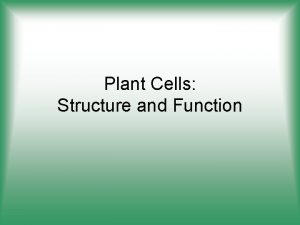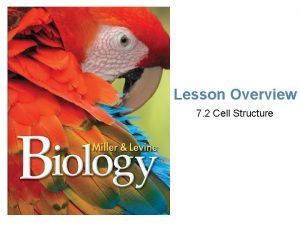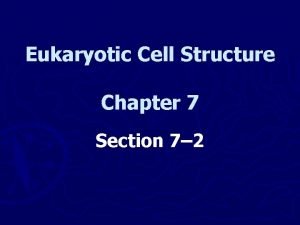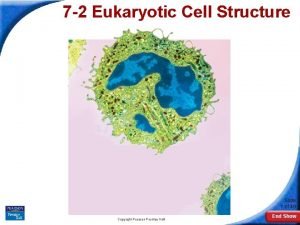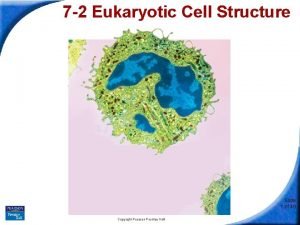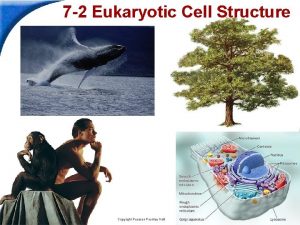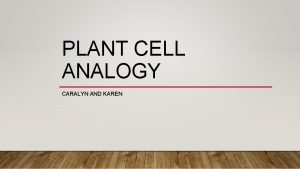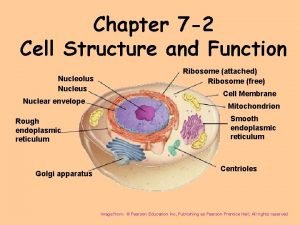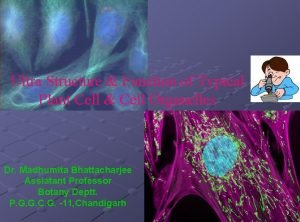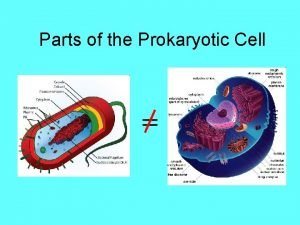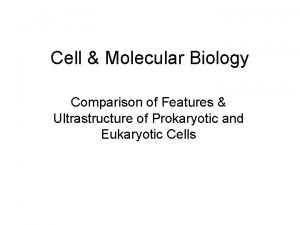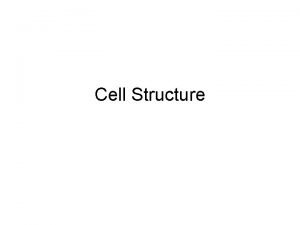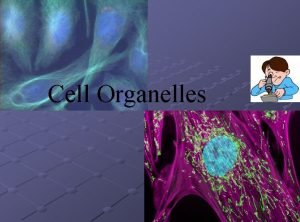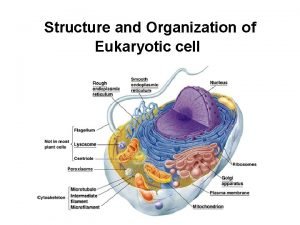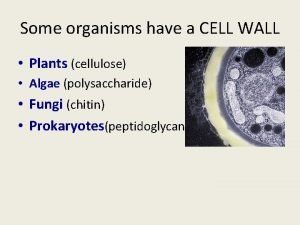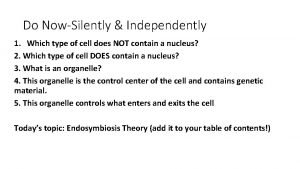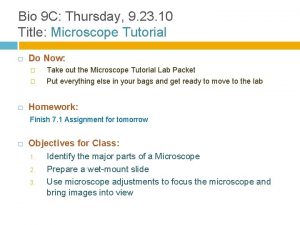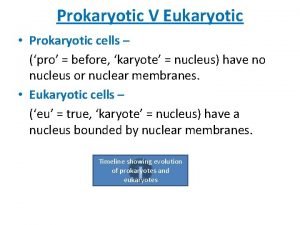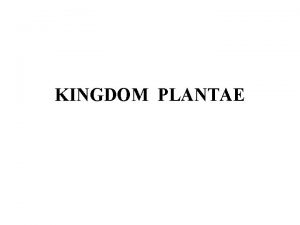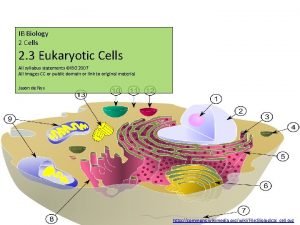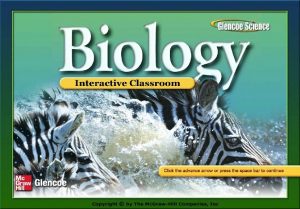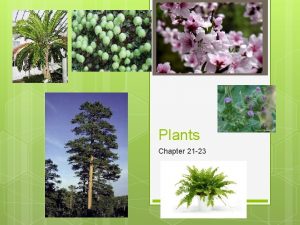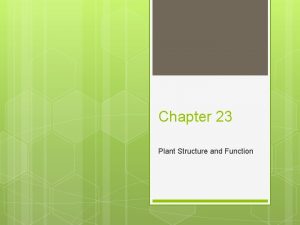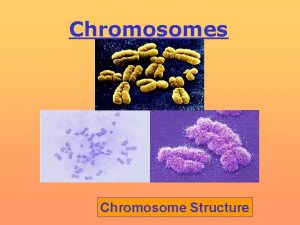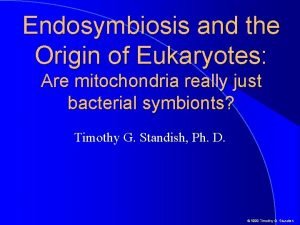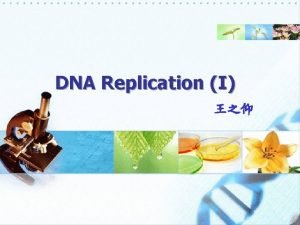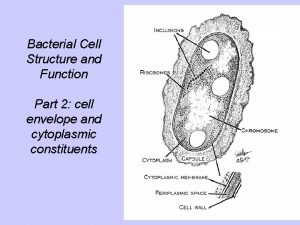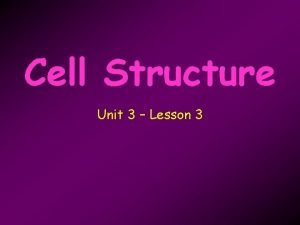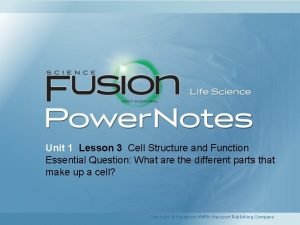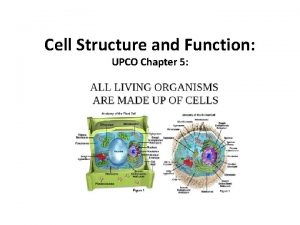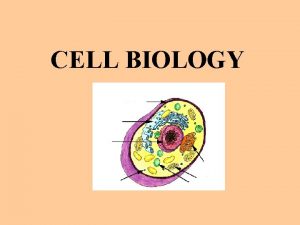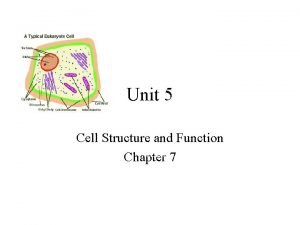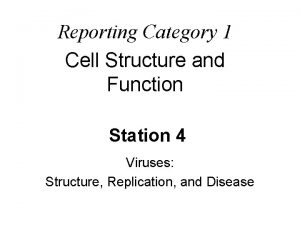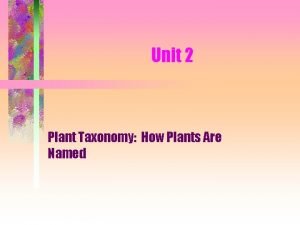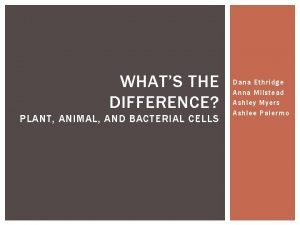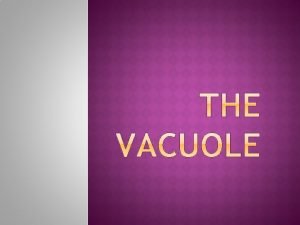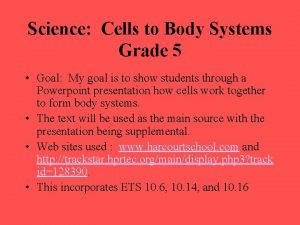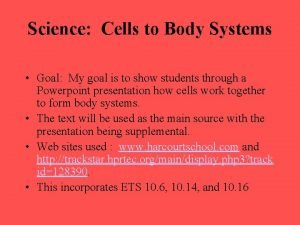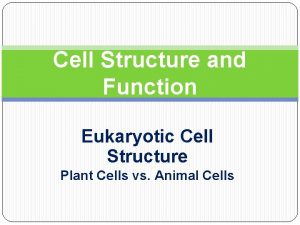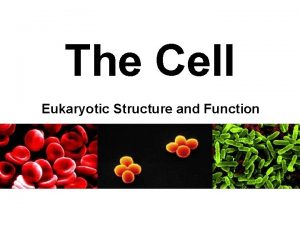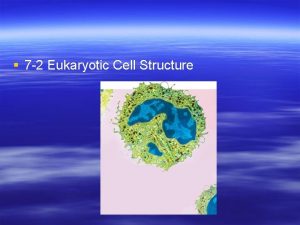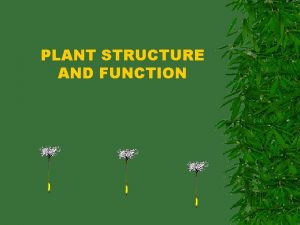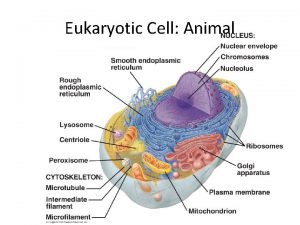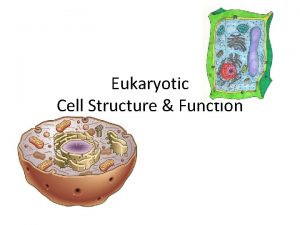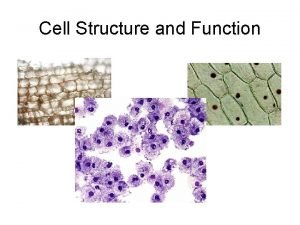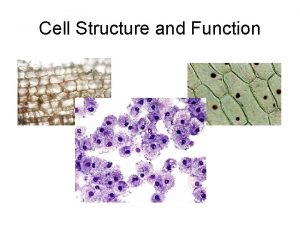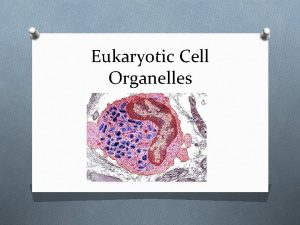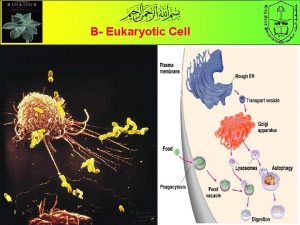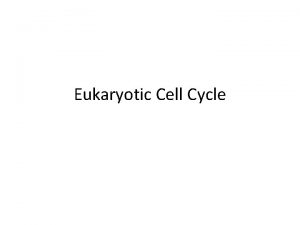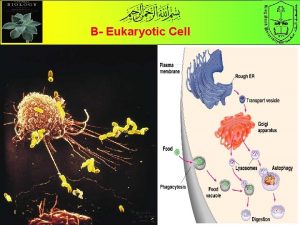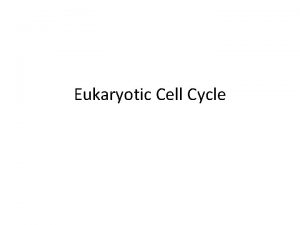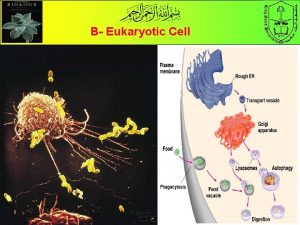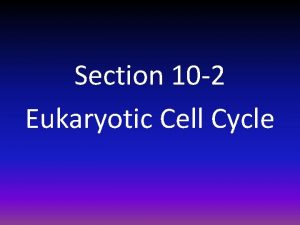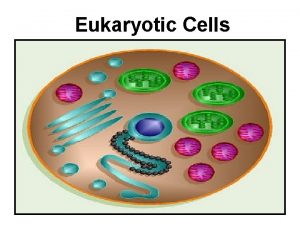Plants Structure Function Plant Cell Plants are Eukaryotic











































































- Slides: 75

Plants: Structure & Function

Plant Cell Plants are: Eukaryotic Autotrophic – have chloroplasts Multicellular Cell walls of cellulose

BRIEF HISTORY OF PLANTS • Theory: many scientists believe that photosynthetic green algae (protist) living near land adapted to life on land. Supporting evidence: – Plants and green algae both have cellulose in their cell walls. – Both use chlorophyll for photosynthesis. – Both store food (glucose) by linking them into long chains of carbohydrates known as starch.

Brief History of Plants • The earliest plant fossils are 450 million years old and were of small simple plants that grew close to the ground and were still dependent on water to complete their life cycle…. even AFTER they made the move to land • Over time plants developed specialized structures that allow them to grow larger and survive further from water. • Plants have evolved different adaptations that there are now many different classifications within the plant kingdom

Plants that live in nitrogen poor soils trap and break down insects with enzymes to obtain nitrogen Venus fly trap Pitcher plant

Cladogram – Evolutionary History

Plant Diversity • Vascular tissues: larger plants need a way to move H 2 O and nutrients throughout the plant. Vascular tissue in plants carries water and sap, just like our vascular tissue carries blood. • Seed type: seeds can form on the surface of a cone or in a protective layer of tissue. • Flowers: many plants have flowers as their reproductive structures. The bight colors and sweet smells can attract pollinators to help in the process. Flowers come in many shapes, sizes and colors. .

4 Main Plant Groups: 1. Bryophytes: non-vascular mosses & other small plants • Non-vascular plants, so they must be low to the ground near water because water must travel into & out of these bryophytes by osmosis.

• Only live in moist areas. Reproduction has to occur in water. • Commercial Value: Moss (peat moss) is commonly added to the soil when gardening to help retain water for the other plants and also to acidify the soil. • Examples: mosses, liverwort, & hornwort

4 Main Plant Groups: 2. Ferns: seedless vascular plants • Vascular tissue allows water and nutrients to be easily moved farther distances so ferns can grow larger than non-vascular plants. • All vascular plants contain true roots, stems, and leaves. • Examples: ferns, horsetails Whisk fern Horsetail Fern

4 Main Plant Groups: • Ferns reproduce using spores instead of seeds. These spores are made on the underside of the leaf in specialized structures called sporangia.

4 Main Plant Groups: 3. Gymnosperm: vascular plants with unprotected seeds on cones • Exposed “naked” seeds on the surface of a cone • There are both male and female cones

Ovulate cone from a pinetree (female) Staminate cone from a pinetree (male)

Gymnoperms • Can live nearly anywhere, because seeds can form without water and remain dormant until water is available. • Many have special needle shaped leaves to minimize water loss • Examples: Cycads, Ginkgoes, Conifers (pine, spruce, cedars, redwoods, junipers, etc. )

Ginkgo Cycad

4 Main Plant Groups: 4. Angiosperm: vascular plants with flowers, and seeds protected by layers of tissue called the fruit • Flowers are unique reproductive organs in angiosperms. The flowers contain an ovary that protects the developing seed. After pollination the ovary develops into a fruit.

Grasses and trees are also flowering plants. Grass flowers

Flower (male) pistil (female)

Pollen grains contain sperm. They are produced in the anthers of the flowers in angiosperms.

Ovaries with ovules become fruits with seeds after the ovule (egg) is fertilized by sperm from the pollen

• Fruits help the seeds to spread by traveling through an animals digestive tract. • Angiosperms (vascular plants with flowers) are divided into 2 classes: monocot and dicot


Cotyledons – non-photosynthetic leaves of an immature plant; provide source of nutrients until plant can produce its own food

Water Conducting Tissue of Vascular Plants

Stems – cross sections through a dicot and a monocot showing the vascular bundles

Angiosperm: Stems: • Woody: stems composed of cells with thick cell walls - includes trees, bushes, vines. • Herbaceous: these are smooth non-woody stemmed plants - include dandelions, petunias, sunflowers

Angiosperm: Life span: • Annuals: plants that complete a life cycle within one year. Ex: zinnias, petunias, and marigolds. • Biennial: plants with a two-year life span. Typically they germinate and establish roots in the first year. Then flower and reproduce in the second. Ex: celery, parsley, and carrots. • Perennials: plants that usually live for many years. Some have stems that die back every winter, but grow back from the roots in the spring. Ex: all trees, peonies, honeysuckle, and most grasses.

Organ Systems in Plants • All plants have 3 main organ systems 1. Roots: absorbs water & dissolved nutrients, anchors plant to the ground, protects the plant from harmful bacteria/fungi in the soil

Organ Systems in Plants Shoot System: 2. Stems: connects roots to leaves, gives the plant support & strength and transports materials throughout the plant. 3. Leaves: structure responsible for photosynthesis in plants, also controls exchange of O 2 and CO 2 through tiny holes in the underside of leaves called stomata. Remember that plants need CO 2 to make glucose in photosynthesis and O 2 to break down the glucose during cellular respiration.

Organ Systems in Plants • Together these organs perform important functions for the plant including transport, protection, and coordination of plant activities.

Plant Tissue Types • Plants are composed of 3 types of tissue: dermal, vascular, & and ground tissue. • These 3 types of tissues combine in different arrangements to form roots, stems, and leaves.

Plant Tissues 1. Dermal Tissue: • The outer layer of the plant. You can think of it as the “skin” of the plant. • This layer of cells is also known as the epidermis. The epidermis excretes a waxy covering known as the cuticle, which helps prevent water from evaporating out of leaves. The cuticle does not cover the roots because plants need to let water into root cells. • In roots the epidermis includes root hairs, and in leaves the dermis can also include the trichomes, special projections that protect the leaf and gives it a fuzzy appearance.

Plant Tissues 2. Vascular Tissue: • Vascular tissue forms a transport system made up of several specialized cells that transport water and nutrients throughout the plant. • (a) Xylem: transport system that carries water and dissolved nutrients upward from the roots to all parts of the plant.

Plant Tissues (b) Phloem: transport system that moves nutrients and carbohydrates (sap) made in photosynthesis throughout the plant. Plants store carbohydrates in areas called sugar sinks but then must transport them back to every cell for cell growth.

Plant Tissues 3. Ground Tissue: • The tissue that lays between the dermal and vascular tissue. Different types of ground tissue cells perform different functions. Some ground tissue cells are responsible for photosynthesis while others add strength to the plant.

Other Types of Plant Tissues Meristematic Tissue: • Unlike other plant tissues, meristematic tissue does not make up plant organs. Meristematic tissue is responsible for plant growth. It is the only plant tissue that can make new cells by mitosis.

Plant Tissues 2 types of meristematic tissue: • Apical meristem: located at the tips of stems and roots. Apical meristem is responsible for lengthening plants. It allows plants to grow taller and form deeper roots. The lengthening of plants is known as primary growth. • Lateral meristem: responsible for secondary growth, which thickens stems and roots. Lateral meristematic tissue surrounds vascular tissue.

Plant Tissues • Once the meristematic tissues form new cells, the cells have to mature into the different types of cells that the plant needs. This process of cells maturing into different types is called differentiation.

Roots • Plant organ that extends underground to: - anchor the plant in place - absorb water and nutrients from the soil - protects plant by preventing bacterial and fungal diseases from entering • 2 types of roots: – Taproot : the primary, thick and long root that other small roots may grow from. Oak trees have long taproots to help them reach water and prevent them from blowing over in the wind. Carrots and radishes store sugar in their taproots. A taproot is a common characteristic of dicots.

Roots - Fibrous Root: branching roots where there is no one large root. Found in grasses and other plants that prevent soil erosion. A fibrous root is a common characteristic of monocots.

• The root has a water proof boundary called the Casparian strip which allows water and dissolved nutrients into the vascular cylinder but prevents if from seeping back out of the root. • The Casparian strip also prevents disease causing bacteria, viruses and fungi from entering the plant • This one-way movement of water causes root pressure which pushes water out of the root and up the stem

Nitrogen fixation – occurs in the roots and in the soil around the roots of plants; performed by bacteria

Stems • Three functions: (a) Produce leaves, branches and flowers (b) Hold leaves up to the light (c) Transport substances between the roots and leaves through the vascular system (xylem and phloem)

Stems • Monocot vs. dicot stems have their vascular tissue arranged differently – Monocot: scattered vascular bundles – Dicot: vascular bundles arranged in rings

Formation of Wood and Bark • The rings within the stem (trunk) of a tree cannot only tell you how old the tree is but it can also show years of drought and years with good growing conditions. The rings can tell the tree’s life story. Formation of Wood • Most of what we call “wood” is actually layers of xylem • As a woody stem grows thicker, the older xylem near the center of the stem no longer conducts water and will become heartwood to help support the tree • Heartwood is surrounded by sapwood which contains active xylem that transfers water and dissolved nutrients

Formation of Wood and Bark

Formation of Bark • Bark: all of the tissues outside the vascular cambium; includes phloem, cork cambium and cork • Vascular Cambium : a meristem that produces new xylem and phloem to increase stem width • Cork Cambium: a meristem that produces the protective layer of cork • Cork: contains phloem that no longer functions

Stems Parts of a stem: • Node: place where the leaves are attached and also an area where buds form which will produce new stems and leaves • Internodes: regions between nodes

Leaves • Leaves are the primary structure for absorbing light & performing photosynthesis • Leaf Structure: – Blade: flattened part of leaf, designed to catch waves of light – Petiole: thin stalk that attaches the leaf to the stem

Leaves • Leaves can be simple or compound which contain many leaflets.

Leaves • The epidermis that covers the top and bottom of the leaf excrete a waxy layer called a cuticle. The cuticle prevents water from evaporating out of the leaf and is much thicker in plants that live in dry climates.

Leaf Function: 1. Photosynthesis: Photosynthesis mostly takes place in the mesophyll layer of the leaves under the upper epidermis. These are special ground tissue cells that are packed full of chloroplasts to trap light energy as it enters the cell. The mesophyll layer also has loosely packed cells that have space for O 2 & CO 2 gas in between them.

Leaf Function: 2. Gas Exchange: • Plants need to absorb CO 2 and release O 2 in order to perform photosynthesis. The underside (ventral) of leaves have tiny holes, called stomata (stoma), that can be opened to exchange these gases.

Leaf Function: • The stomata can be opened and closed by guard cells that surround them. The guard cells swell with water to close the stomata and remove water from the cells to open the stomata. • Plants have to balance having the stomata open long enough to get the gases it needs for photosynthesis, but not long enough to lose water

Leaf Function: 3. Limit Transpiration: • Transpiration is the loss of water in plants by evaporation. Plants need water for all cellular activities, so its loss has to be limited. • As water is lost by transpiration, it pulls more water into the leaves through the xylem. It is similar to sucking on a straw.

Transport in Plants: Water Transport: • Water moves through the plant by the forces exerted by root pressure, capillary action, and transpiration. Transpiration is the strongest of these forces. – Root pressure: the upward pressure caused by the 1 -way flow of water through the Casparian strip into the vascular cylinder in the root.

Transport in Plants: • Capillary action: water has a strong force of adhesion, meaning it sticks to things. Water sticks to the narrow tubes of the xylem instead of falling back down due to gravity. • Transpiration: as water transpires out of the leaves it pulls the next water molecule up the xylem and into the leaf.

Transport in Plants: Nutrient Transport: • Phloem moves sugar and other nutrients into areas of the plant for storage, then back to cells as they are needed. – A sink is a location where the plants stores sugar. This could be in a fruit, root, or other location depending on the species. Many cold weather plants will store sugar underground in the roots during winter, then pump it back to the rest of the plant when temperatures warm up.

Reproduction in Plants: • Flowers are the reproductive organs of angiosperms. Flowers can contain both male and female parts and are often brightly colored in order to attract pollinators.

(male part) Stamen Part produces the male Anther gamete, pollen holds the anther to Filament the flower Stigma Carpel (female part) Function sticky, top part of the carpel where pollen sticks Style connects the stigma to the ovary Ovary wide base of flower where female gametes are formed in the ovules

Sepal outer most part of flower, often looks like tiny leaves, protects the bud during formation Petal brightly colored part of the flower, attracts pollinators

Pollination & Fertilization: • Pollen is carried to a flower by wind, insects, and on the fur/feathers of animals. • After the pollen grain lands on the stigma of the same species of flower, a pollen tube grows out of the pollen grain through the style to make sure that the sperm is delivered to the gametes located in the ovule of the ovary.

Seeds: • The seeds of angiosperms are very successful because they can be dormant until conditions are right to grow. Dormant seeds are alive but not growing. • As seeds mature the ovary walls thicken and form a fruit to protect the developing seed. • Fruits form in various shapes and sizes and can aid in the dispersal of the seeds

Seeds: • Seeds Dispersed by animals: some fruits, like stickers, have coatings that stick to the fur of animals, others are tasty so the animal eats them. The fruit is digested but the seed passes through unharmed and is dropped off away from the parent plant so they won’t have to compete for water and soil.

Seeds: • Seeds Dispersed by Wind or Water: typically light weight and sometimes have winglike extensions so they can fly through the air or float on water.

Germination: early growth of plant embryo • Absorbed water cracks open the seed coat and the plant begins to grow. • Cotyledons are the first leaves that emerge out of the seed. Monocots have 1 cotyledon and dicots have 2. • Plants can’t do photosynthesis and obtain energy until the leaves are out of the soil and in light, so they live off of the stored energy found in the endosperm of the seed.

Plant Responses Tropisms: a plant’s response to external stimuli in a particular direction 1. Gravitropism: plants response to gravity. Plants know to grow their roots down and their stems up. 2. Phototropism: plants grow towards light and move their leaves to absorb the light they need for photosynthesis.

Plant Responses 3. Thigmotropism: plants response to touch. Plants that are touched regularly can have stunted growth or grow away from the touching. Other plants, like vines, grow towards touch and attach themselves with tendrils.

Plant Responses 4. Nastic Response: a plant’s movement without a particular direction. – Venus fly trap

Plant Hormones • Hormones: chemicals that control growth and responses in a plant • Types of Hormones 1. Cytokines: hormone formed in growing roots and developing seeds and fruits. It stimulates cell division and is responsible for causing dormant cells to sprout.

Plant Hormones 2. Auxins: hormone made in the apical meristem that controls the elongation of cells – Auxins can cause cells on one side of the plant to elongate on just one side to make the plant bend. Important in phototropism and gravitropism.

3. Gibberellins: hormone that causes an increase in size of stems and fruits. 4. Ethylene Gas: chemical that stimulates fruits to ripen. – Many commercial farms pick fruit and vegetables before they are ripe, ship them across the country, and then spray them with ethylene gas in storage warehouses.

Fruit or Veggie ? Humans eat lots of different plant parts. A fruit is the ripened ovary and contains seeds. Therefore, tomatoes, peppers, squash, olives, and cucumbers are fruits, not vegetables.

Vegetables – the vegetative parts of the plants that we eat. Includes: Roots – carrots, turnips, radishes Stems – celery, bok choi, rhubarb, garlic, broccoli, onions, potatoes Leaves – lettuce, cabbage, parsley, cilantro Other plant parts that we eat: Seeds – pinto beans, peas, sunflower seeds, corn, rice, pecans, coconut Flowers – anise flowers (licorice), basil

We don’t just eat plants, we also wear them, build with them, and use them for medicines!
 Antigentest åre
Antigentest åre Eukaryotic cell structure plant
Eukaryotic cell structure plant What is the function of a cell
What is the function of a cell Prokaryotic vs eukaryotic cell
Prokaryotic vs eukaryotic cell Linear chromosomes in eukaryotes
Linear chromosomes in eukaryotes Life
Life Carbohydrate side chain
Carbohydrate side chain Prokaryotic cell vs eukaryotic
Prokaryotic cell vs eukaryotic Is cytoplasm in plant and animal cells
Is cytoplasm in plant and animal cells Eukaryotic cell structure
Eukaryotic cell structure Most nuclei contain a small dense region known as the
Most nuclei contain a small dense region known as the Biology chapter 7 cell structure and function
Biology chapter 7 cell structure and function 7-2 eukaryotic cell structure
7-2 eukaryotic cell structure Section 7-2 eukaryotic cell structure
Section 7-2 eukaryotic cell structure Section 7-2 eukaryotic cell structure
Section 7-2 eukaryotic cell structure Venn diagram plant and animal cell
Venn diagram plant and animal cell Venn diagram animal and plant cell
Venn diagram animal and plant cell Vacuole function
Vacuole function Whats the difference between plant and animal cells
Whats the difference between plant and animal cells Idealized plant cell
Idealized plant cell What is the gooey liquid in plant and animal cells
What is the gooey liquid in plant and animal cells Are plant cells prokaryotic or eukaryotic
Are plant cells prokaryotic or eukaryotic Are plants eukaryotic
Are plants eukaryotic Are plants eukaryotic
Are plants eukaryotic Analogy for plant cell
Analogy for plant cell Endoplasmic reticulum function in plant cell
Endoplasmic reticulum function in plant cell Plant and animal cell under electron microscope
Plant and animal cell under electron microscope Which organelle
Which organelle Parts of a eukaryotic cell
Parts of a eukaryotic cell Typical eukaryotic cell
Typical eukaryotic cell Eukaryotic cell organisation
Eukaryotic cell organisation Eukaryotic cell
Eukaryotic cell Fungi locomotion present or absent
Fungi locomotion present or absent Are cell walls prokaryotic or eukaryotic
Are cell walls prokaryotic or eukaryotic Eukaryotic cell
Eukaryotic cell Are plants multicellular eukaryotes
Are plants multicellular eukaryotes Eukaryotic cell questions
Eukaryotic cell questions Organelle speed dating
Organelle speed dating Pro karyote
Pro karyote Algae classification kingdom
Algae classification kingdom Ib biology eukaryotic cell diagram
Ib biology eukaryotic cell diagram Which compares prokaryotes and eukaryotes
Which compares prokaryotes and eukaryotes Chapter 22 plant structure and function answer key
Chapter 22 plant structure and function answer key Chapter 21 plant structure and function
Chapter 21 plant structure and function Chapter 23 plant structure and function
Chapter 23 plant structure and function Prokaryotic chromosome vs eukaryotic chromosome structure
Prokaryotic chromosome vs eukaryotic chromosome structure What happens in telophase
What happens in telophase Eukaryotic chromosome structure
Eukaryotic chromosome structure Eukaryotic chromosome structure
Eukaryotic chromosome structure What is part 2
What is part 2 Lesson 3 cell structure and function answer key
Lesson 3 cell structure and function answer key Cells graphic organizer
Cells graphic organizer Lesson 3 cell structure and function answer key
Lesson 3 cell structure and function answer key Chapter 7 cell structure and function section review 7-2
Chapter 7 cell structure and function section review 7-2 Cell organelle graphic organizer answer key
Cell organelle graphic organizer answer key Chapter 5 cell structure and function
Chapter 5 cell structure and function Plastids in plant cell
Plastids in plant cell Unit 5 cell structure and function answer key
Unit 5 cell structure and function answer key Category 1 cell structure and function
Category 1 cell structure and function Category 1 cell structure and function
Category 1 cell structure and function Category 1: cell structure and function
Category 1: cell structure and function Objective of plant breeding
Objective of plant breeding Plant introduction in plant breeding
Plant introduction in plant breeding Plant introduction in plant breeding
Plant introduction in plant breeding Tronsmo plant pathology and plant diseases download
Tronsmo plant pathology and plant diseases download Tronsmo plant pathology and plant diseases download
Tronsmo plant pathology and plant diseases download Albugo eye
Albugo eye How plants are named
How plants are named Nonvascular plants definition
Nonvascular plants definition Non vascular plants
Non vascular plants Characteristic of non flowering plants
Characteristic of non flowering plants C3 plant
C3 plant Whats the difference between animal and plant cells
Whats the difference between animal and plant cells Do animal cells have vacuoles
Do animal cells have vacuoles Plant cell meaning
Plant cell meaning Definition of nucleus in a plant cell
Definition of nucleus in a plant cell

